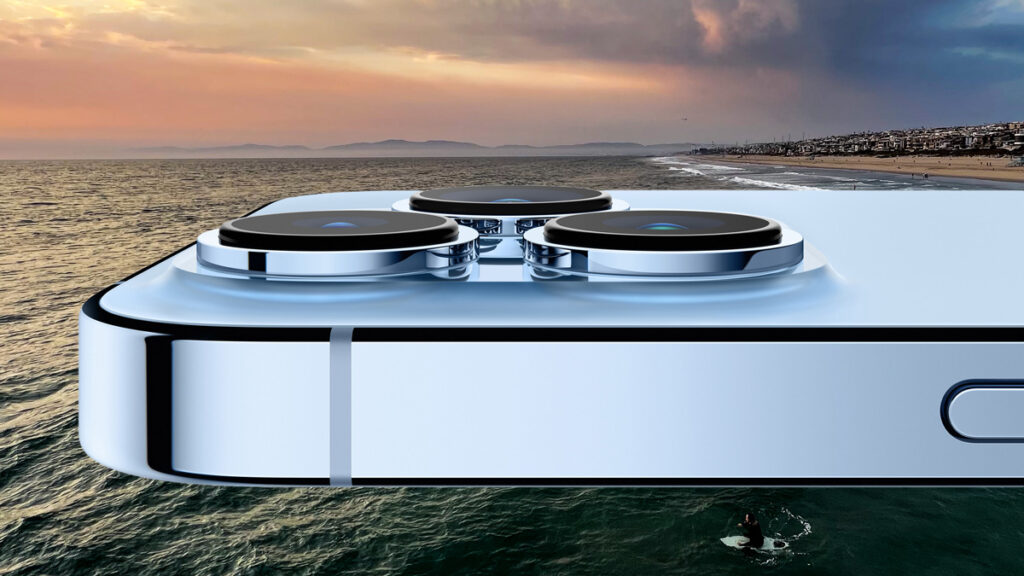Apple
Deeper Dive into iPhone 13 Pro Max Cameras after 48 Hours of Testing
Published
3 years agoon

The cameras are at the center of what makes an iPhone 13 a Pro investment
Direct hands on experience with something as complex and interesting as the new iPhone 13 Pro Max is invaluable for a useful assessment. After a few days and also taking into account some observations of others I will attempt to shed light on the state of the art of iPhone as of September 2021.
Comparing this iteration of iPhone with the previous versions is meaningful for buying decisions, but it must also be compared based on what it can do for a professional that has a need for a higher grade of gadget.
Judging and comparing the machine as a whole is also necessary, since the cameras are not cameras at all be just one part of an integrated system of visual (and audio!) production tools.
Big changes that begat others and on the circle goes
The first thing I noticed, out of the box was the sheer size of the 13 Pro Max, particularly compared to the 11 Pro Max, which was my previous workhorse. From photos I had gathered that the three cameras stuck out more and, yet they do, so much so that it is almost comical.
If you brave the world sans case and put this monster in your the back pocket of your loose fitting jeans, the bulge from the cameras will feel like you are doing something crazy, as it is as if they are rubbing against anything they touch, continuously.
That’s not all about the physical size, though. Looking at the diameter of the three circles (lenses) they appear significantly larger. Believe me, they are. Since the 11 Pro max and the 12 Pro Max have the same size triple camera layout (spec upgrades notwithstanding) this is an immediate and obvious change.

Above: Photo / Lynxotic
The increased size and weight of the camera itself is noticeable, more than I expected. The screen appears far larger due to the new specs and it is a bit of a shock at first, but the level of quality is the biggest and most noticeable feature.

The design logic has an implied history that jumps out once you start to use the camera system.
The changes to the three cameras are significant. After two years of using the 2019 11 Pro Max the framing options, based on the three lenses is a complete new experience.
The ultra wide 13mm equivalent is a bit of a bold and crazy choice. If I was ordering a set of lenses for a music video shoot the ultra wide might go as far as 11mm (very wide!) but that is basically an EFX look and causes an almost fish-eye look.
The 13mm is literally as wide as you can get without getting into potential “clown” territory, which is fun but not usable for a non-EFX composition.
What is odd, in a way, is that the “main” lens at 26mm equivalent is still very wide meaning that the standard 40mm equivalent, which was always considered the closest to a neutral look, is absent here.
Similarly, the telephoto lens at a 77mm equivalent is exactly the same type of choice – once again in my kit this would have been a 100mm for a deep bokeh and a noticeable sweet spot that is ultra-flattering for close ups and head shots.
The 77mm, therefore, is a long enough lens to get the magnification and emulate the look of a telephoto style. But wait, no glass no bokeh.

This is where the logic of the design and how the system works, as a whole, begins to get deep.
Once you have made the commitment to not only extend the range of the entire optical focal length range to 6x the differences between a glass & steel 77mm prime lens and a “cell phone camera” must be addressed.
The 77mm requires the bokeh and relatively narrow in-focus range of a “real” telephoto lens is the stylized creative uses that a full kit of prime lenses makes possible is to be achieved.
This is addressed with the already present portrait mode – with enhanced functionality made possible by the A15 chip, the machine learning, AI and neural network – in other words software and computational assists.
And for video, cinematic mode is an absolute must – since the same bokeh effect and stylized effects are needed and desired for video.
All of this does not include the macro effects that effectively extend the range into the nearly microscopic. This feature requires a whole article, which you can check out here.
Getting to a full photographic system in your pocket, and beyond.
Once the effects and artifacts of the 77mm style glass prime lens have been added to the mix, emulated things get more interesting.
Since the bokeh and artifacts in the cinematic mode for video are computational and not photographic, they are stored separately and can be altered after the fact, just like has been the case with portrait mode all along.
This is a big deal in one way, since it could never be conceived of with traditional lenses and cameras. It also, however, one more variable to consider when putting together a large batch of footage for a project. This adds a new layer of creative flexibility, and choices to contend with.
Further, since the long lens stylizations are a byproduct of and influenced by focus settings, that has to be in the mix also. That produced the need for the cinematic mode which you can think of as a slightly stoned robot focus puller. who is also a little bit psychic.

The first robot camera assistant is already in the box when your phone arrives
Let me explain…. A real life focus puller (doing rack focus settings) in real life would function roughly as follows:
A shot is planned that requires a focus pull from one subject to another – this could be a close shot of a face panning to another face, or a close up that refocuses from the foreground to the background, for example. The focus must also factor in any movement of the camera / dolly.
The two desired subject distances are measured (using a tape measure) and the focus settings noted. In complex shots this can be multiple focus settings and a particular speed of the “rack pull” from one to the next.
Often such complex focus / dolly set ups must be rehearsed multi times just for the focus puller – so that his error does not ruin a perfect take when, for example, the actors get their best performances.
So, in the robot world practice is also good – and a plan is almost essential, but the virtual focus puller will go with the flow, and try to anticipate and predict what you want him to focus on in real time as you shoot.
This is pretty incredible and also, much like autocorrect typing, sometimes very successful and sometimes comical in the outcome. What is tricky is how to get the robot puller to know what you are trying to have as a subject if it is not a persons head or face.
Also, if the action is fast or if you are shooting something that has no pre-determined outcome or script, like a political protest or a sporting event, you will get somewhat random results.
This makes the name apt, since cinematic also implies a movie with a plot and a script.

Conclusions and a few known limitations and caveats
Human greed is a powerful thing. When given a photographic system that even attempts to approximate a profession system based on prime and zoom lenses and accessories, there’s a tendency to want it all, right now!
Of course, instead, what we get is an amazing extension of the iPhone photo tradition – taken up a bunch of notches at once. The computational enhancements are incredible and will only get better – in many cases without a new phone as they are based on AI and machine learning, which as the name implies, are continually improving while you sleep.
There are specific limitations though that should be mentioned about the iPhone 13 Pro camera system.
Cinematic mode only works (currently) in 1080p. This is a serious limitation, since the whole idea of Pro is 4k and above. There are rumors that this could get a software upgrade during the year but it is not clear if or when that will happen.
Along with the lack of slo-mo at any resolution above 1080p there is a lot of disappointment in this issue. It is the reality of how difficult the computational “assist” really is to achieve that makes this a big step that is still in the future.
It is also the reason why real lenses and traditional DLSR cameras still have an important use and value.
The new system unveiled with the iPhone 13 pro is revolutionary precisely because of the potential for people to create new visual expressions and ways of communicating.
These photographic traditions and the efforts that were made in the design to emulate them are important and valuable. However, the future will benefit from the spontaneous and new ways that people will decide to use this evolving system and the current extensions of our eyes, ears and minds….
- Apple Reveals new MacBook Pro Models, Mac Mini: all with M2 and M2 Pro Chips
- Fitness with Apple Watch: A Day in the Life of Highly Motivated Ring Closers
- The Vision of Steve Jobs for the Future of Apple has Barely Begun to Emerge
- Best thing about the new Mac Studio Display? It’s Optional with the Mac Studio Desktop…
- iPhone Subscription Service Could Launch This Year according to Gurman
Wide (main) cameras:
Lens Sensor Area
iPhone 13 Pro / Max 26mm equiv. F1.5 44mm2 (1/1.65″)
iPhone 12 Pro 26mm equiv. F1.6 23.9mm2 (1/2.55″)
iPhone 12 Pro Max 26mm equiv. F1.6 35.2mm2 (1/1.9″)
Pro 12MP camera system: Telephoto, Wide, and Ultra Wide cameras
- Telephoto: ƒ/2.8 aperture
- Wide: ƒ/1.5 aperture
- Ultra Wide: ƒ/1.8 aperture and 120° field of view
- 3x optical zoom in, 2x optical zoom out; 6x optical zoom range
- Digital zoom up to 15x
- Night mode portraits enabled by LiDAR Scanner
- Portrait mode with advanced bokeh and Depth Control
- Portrait Lighting with six effects (Natural, Studio, Contour, Stage, Stage Mono, High‑Key Mono)
- Dual optical image stabilization (Telephoto and Wide)
- Sensor‑shift optical image stabilization (Wide)
- Six‑element lens (Telephoto and Ultra Wide); seven‑element lens (Wide)
- True Tone flash with Slow Sync
- Panorama (up to 63MP)
- Sapphire crystal lens cover
- 100% Focus Pixels (Wide)
- Night mode
- Deep Fusion
- Smart HDR 4
- Photographic Styles
- Macro photography
- Apple ProRAW
- Wide color capture for photos and Live Photos
- Lens correction (Ultra Wide)
- Advanced red‑eye correction
- Photo geotagging
- Auto image stabilization
- Burst mode
- Image formats captured: HEIF and JPEG
Find books on Political Recommendations and many other topics at our sister site: Cherrybooks on Bookshop.org
Enjoy Lynxotic at Apple News on your iPhone, iPad or Mac.
Lynxotic may receive a small commission based on any purchases made by following links from this page


